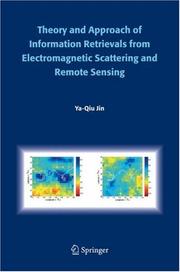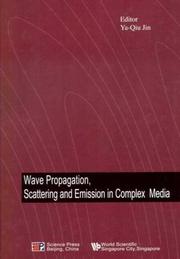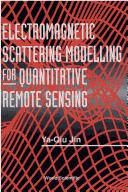| Listing 1 - 10 of 10 |
Sort by
|

ISBN: 1280624671 9786610624676 140204030X 1402040296 Year: 2006 Publisher: Dordrecht : Springer,
Abstract | Keywords | Export | Availability | Bookmark
 Loading...
Loading...Choose an application
- Reference Manager
- EndNote
- RefWorks (Direct export to RefWorks)
Advances in space-borne remote sensing have significantly changed the mankind viewpoint how to observe our own Earth planet. Great amount of remote sensing data and images presents new resources to quantitatively describe and monitor our Earth environment, atmosphere, oceanic and land surfaces. In remote sensing, electromagnetic (EM) scattering, emission and wave propagation, as interaction with the Earth environment, lay the physical basis for understanding and extracting geoscientific information. Study of electromagnetic waves with remote sensing application has become an active and interdisciplinary area. This book presents some new progress on the theoretical and numerical approaches for information retrieval of the remote sensing via EM scattering and emission. We begin in Chapter 1 with the vector radiative transfer (VRT) theory for inhomogeneous scatter media. The VRT takes account of multiple scattering, emission and propagation of random scatter media, and quantitatively leads to insights of elucidating and understanding EM wave-terrain surface interaction. Meanwhile, it is extensively applicable to carrying out data interpretation and validation, and to solving the inverse problem, e.g. iteratively, physically or statistically. In Chapter 1, iterative solutions of multiple scattering and emission from inhomogeneous dense scatter media, and inhomogeneous non-spherical scatter media are discussed. Three-dimensional VRT equation (3D-VRT) for spatially inhomogeneous random scatter media for high resolution observation is also investigated. The polarimetric imagery of synthetic aperture radar (SAR) technology is one of most important advances in space-borne microwave remote sensing during recent decades.
Electromagnetic waves --- Remote sensing. --- Scattering. --- Remote-sensing imagery --- Remote sensing systems --- Remote terrain sensing --- Sensing, Remote --- Terrain sensing, Remote --- Aerial photogrammetry --- Aerospace telemetry --- Detectors --- Space optics --- Scattering (Physics) --- Computer engineering. --- Engineering. --- Electrical Engineering. --- Classical Electrodynamics. --- Complexity. --- Solid State Physics. --- Spectroscopy and Microscopy. --- Computers --- Construction --- Industrial arts --- Technology --- Design and construction --- Electrical engineering. --- Optics. --- Electrodynamics. --- Computational complexity. --- Solid state physics. --- Spectroscopy. --- Microscopy. --- Analysis, Microscopic --- Light microscopy --- Micrographic analysis --- Microscope and microscopy --- Microscopic analysis --- Optical microscopy --- Optics --- Analysis, Spectrum --- Spectra --- Spectrochemical analysis --- Spectrochemistry --- Spectroscopy --- Chemistry, Analytic --- Interferometry --- Radiation --- Wave-motion, Theory of --- Absorption spectra --- Light --- Spectroscope --- Physics --- Solids --- Complexity, Computational --- Electronic data processing --- Machine theory --- Dynamics --- Electric engineering --- Engineering --- Qualitative --- Spectrometry --- Analytical chemistry

ISBN: 1281898872 9786611898878 9812702865 9789812702869 9787030124647 7030124642 7030124642 9812387714 9789812387714 9781281898876 Year: 2004 Publisher: Beijing, China : Singapore : Science Press ; World Scientific,
Abstract | Keywords | Export | Availability | Bookmark
 Loading...
Loading...Choose an application
- Reference Manager
- EndNote
- RefWorks (Direct export to RefWorks)
This book contains review papers presented at the International Workshop on Wave Propagation, Scattering and Emission on Theory, Experiment, Simulation and Inversion (WPSE). The papers are of high quality, covering broad areas: a new mechanism of interaction of electromagnetic waves with complex media, remote sensing information, computational electromagnetics, etc. This book summarizes the most significant progress in wave propagation, encompassing theory, experiment, simulation, and inversion. It will also serve as a good reference for scientists in future research.
Electromagnetic waves. --- Electromagnetic waves --- Scattering (Physics) --- Radiative transfer. --- Remote sensing. --- Wireless communication systems. --- Scattering.

ISBN: 9810216483 Year: 1993 Publisher: Singapore ; New Jersey : World Scientific,
Abstract | Keywords | Export | Availability | Bookmark
 Loading...
Loading...Choose an application
- Reference Manager
- EndNote
- RefWorks (Direct export to RefWorks)
Digital
ISBN: 9781402040306 Year: 2006 Publisher: Dordrecht Springer
Abstract | Keywords | Export | Availability | Bookmark
 Loading...
Loading...Choose an application
- Reference Manager
- EndNote
- RefWorks (Direct export to RefWorks)
Geodesy. Cartography --- Electromagnetism. Ferromagnetism --- Solid state physics --- Electronics --- Engineering sciences. Technology --- Computer. Automation --- golfmechanica --- fotogrammetrie --- lasers (technologie) --- remote sensing --- informatica --- spectroscopie --- systeemtheorie --- elektrodynamica --- elektronica --- fysica --- elektromagnetisme --- informatietheorie
Book
ISBN: 1118188160 1299315917 1118188152 9781118188149 9781299315914 1118188144 9781118188132 1118188179 9781118188170 9781118188156 9781118188163 Year: 2013 Publisher: Singapore : [Piscataqay, New Jersey] : John Wiley & Sons Singapore Pte. Ltd., IEEE Xplore,
Abstract | Keywords | Export | Availability | Bookmark
 Loading...
Loading...Choose an application
- Reference Manager
- EndNote
- RefWorks (Direct export to RefWorks)
An essential reference on polarimetric Synthetic Aperture Radar (SAR), this book uses scattering theory and radiative transfer theory as a basis for its treatment of topics. It is organized to include theoretical scattering models and SAR data analysis techniques, and presents cutting-edge research on theoretical modeling of terrain surface. The authors include quantitative approaches for remote sensing, such as the analysis of the Mueller matrix solution of random media, and mono-static and bistatic SAR image simulation. Jin and Xu also cover new parameters for unsupervised surface classification, DEM inversion, change detection from multi-temporal SAR images, reconstruction of building objects from multi-aspect SAR images, and polarimetric pulse echoes from multi-layering scatter media.Structured to encourage methodical learning, earlier chapters cover core material, while later sections involve more advanced new topics which are important for researchers. The final chapter completes the book as a reference by covering SAR interferometry, a core topic in the remote sensing community.The book is designed for researchers, engineers and scientists working on polarimetric SAR hardware and software, application developers of SAR and polarimetric SAR, and remote sensing specialists working with SAR data, using ESA, Radarsat and ALOS data. The book is also geared for a number of other related readers:. Users of the technology in agriculture, earth science, environmental sciences, forestry, oceanography. Students and specialists working in geomatics and using remote sensing data in hazardous areas for earthquakes, landslides, and floods. Graduate students in electric engineering, physics, earth and space sciences. Features theoretical scattering models and SAR data analysis techniques. Explains the simulation of SAR images for mono- and bi-static radars, covering both qualitative and quantitative information retrieval. Chapter topics include: theoretical scattering models; SAR data analysis and processing techniques; and theoretical quantitative simulation reconstruction and inversion techniques. Structured to enable both academic learning and independent study, laying down the foundations first of all before advancing to more complex topics. Experienced author team presents mathematical derivations and figures so that they are easy for readers to understand. Pitched at graduate-level students in electrical engineering, physics, earth and space sciences, as well as researchers. MATLAB code available for readers to run their own routines.
Synthetic aperture radar. --- Electromagnetic waves --- Scattering.
Book
ISBN: 9781402040306 Year: 2006 Publisher: Dordrecht Springer Netherlands
Abstract | Keywords | Export | Availability | Bookmark
 Loading...
Loading...Choose an application
- Reference Manager
- EndNote
- RefWorks (Direct export to RefWorks)
Advances in space-borne remote sensing have significantly changed the mankind viewpoint how to observe our own Earth planet. Great amount of remote sensing data and images presents new resources to quantitatively describe and monitor our Earth environment, atmosphere, oceanic and land surfaces. In remote sensing, electromagnetic (EM) scattering, emission and wave propagation, as interaction with the Earth environment, lay the physical basis for understanding and extracting geoscientific information. Study of electromagnetic waves with remote sensing application has become an active and interdisciplinary area. This book presents some new progress on the theoretical and numerical approaches for information retrieval of the remote sensing via EM scattering and emission. We begin in Chapter 1 with the vector radiative transfer (VRT) theory for inhomogeneous scatter media. The VRT takes account of multiple scattering, emission and propagation of random scatter media, and quantitatively leads to insights of elucidating and understanding EM wave-terrain surface interaction. Meanwhile, it is extensively applicable to carrying out data interpretation and validation, and to solving the inverse problem, e.g. iteratively, physically or statistically. In Chapter 1, iterative solutions of multiple scattering and emission from inhomogeneous dense scatter media, and inhomogeneous non-spherical scatter media are discussed. Three-dimensional VRT equation (3D-VRT) for spatially inhomogeneous random scatter media for high resolution observation is also investigated. The polarimetric imagery of synthetic aperture radar (SAR) technology is one of most important advances in space-borne microwave remote sensing during recent decades.
Geodesy. Cartography --- Electromagnetism. Ferromagnetism --- Solid state physics --- Electronics --- Engineering sciences. Technology --- Computer. Automation --- golfmechanica --- fotogrammetrie --- lasers (technologie) --- remote sensing --- informatica --- spectroscopie --- systeemtheorie --- elektrodynamica --- elektronica --- fysica --- elektromagnetisme --- informatietheorie
Book
Year: 2000 Publisher: [Place of publication not identified] Publishing House of Electronics Industry
Abstract | Keywords | Export | Availability | Bookmark
 Loading...
Loading...Choose an application
- Reference Manager
- EndNote
- RefWorks (Direct export to RefWorks)
Antennas (Electronics) --- Electromagnetic theory --- Electromagnetic waves --- Scattering
Book
Year: 2000 Publisher: [Place of publication not identified] Publishing House of Electronics Industry
Abstract | Keywords | Export | Availability | Bookmark
 Loading...
Loading...Choose an application
- Reference Manager
- EndNote
- RefWorks (Direct export to RefWorks)
Book

ISBN: 9783112319307 Year: 2020 Publisher: Berlin Boston
Abstract | Keywords | Export | Availability | Bookmark
 Loading...
Loading...Choose an application
- Reference Manager
- EndNote
- RefWorks (Direct export to RefWorks)
Digital

ISBN: 9783112319307 9783112308035 Year: 2020 Publisher: Berlin ;; Boston De Gruyter
Abstract | Keywords | Export | Availability | Bookmark
 Loading...
Loading...Choose an application
- Reference Manager
- EndNote
- RefWorks (Direct export to RefWorks)
| Listing 1 - 10 of 10 |
Sort by
|

 Search
Search Feedback
Feedback About UniCat
About UniCat  Help
Help News
News